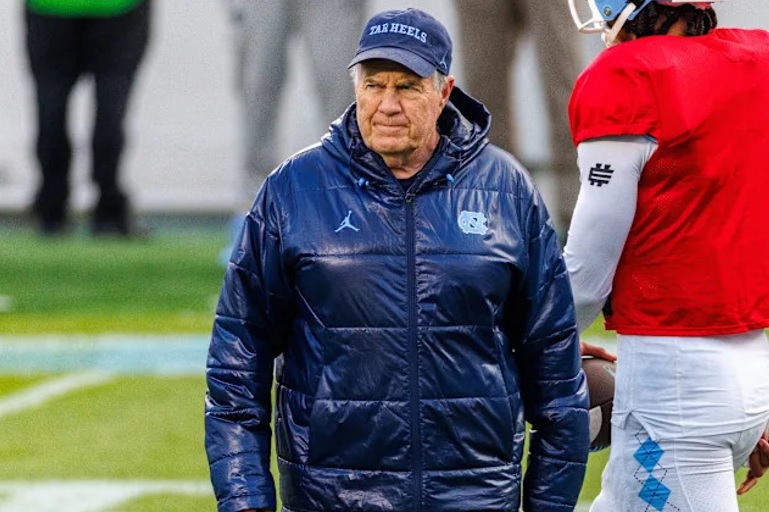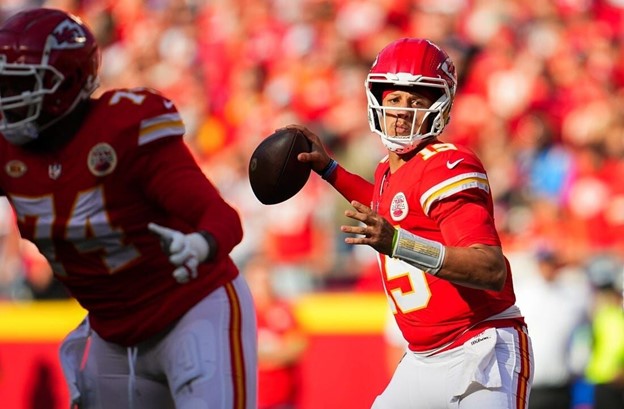The University of North Carolina football program is facing a pivotal moment under new head coach Bill Belichick. With five games completed in the 2025 season, UNC fans and analysts are searching for signs of whether the program will strengthen its national presence or risk the slow decline that has consumed other once-proud college football powers.
Bill Belichick’s Arrival in Chapel Hill
The hiring of Bill Belichick immediately shifted expectations for UNC football. Belichick’s reputation as the architect of defensive-minded, fundamentally disciplined teams was brought to Chapel Hill to correct years of inconsistency.
While his NFL résumé towers over the college game, the question is whether his philosophy can transition to the realities of college football recruiting, roster turnover, and scheduling. Early returns suggested improvement in defensive execution, although rough back-to-back losses against UCF and Clemson, allowing 34 and 38 points respectively in those contests, and flaws in depth and offensive balance could test how far Belichick’s impact can reach in year one.
Belichick’s brand has always centered on defense, and UNC’s initial outings reflected his influence. Tackling angles were sharper, run fits stronger, and the ability to get off blocks far more reliable than in past seasons.
The stark difference between the current Tar Heels and the units that supported quarterbacks like Sam Howell and Drake Maye was already noticeable through Weeks 1-3, though roster limitations were exposed in the setbacks against UFC and Clemson, which means the program cannot yet boast a lineup full of NFL-bound defenders.
The Blowout Win Against Richmond As a Bright Spot So Far
UNC’s 41-6 win over Richmond showcased a team rediscovering its rhythm, executing with precision on both sides of the ball while showing improved balance under pressure. Coverage and analysis from BetCarolina research, which recently examined how once-dominant college football programs have declined in its breakdown of which dynasties have fallen the furthest this century, adds meaningful context to UNC’s rise.
As that report notes, maintaining consistency through coaching transitions and roster turnover is what separates sustained contenders from those that fade, a standard the Tar Heels appear determined to uphold as they rebuild their identity for the 2025 season.
That steady improvement on the field has reignited statewide confidence, especially as fans look for signs that UNC’s rebuild can hold up through conference play.
Across North Carolina, supporters are following roster updates, defensive stats, and quarterback efficiency more closely than ever, often turning to betting apps in NC to compare team trends and weekly projections as part of that deeper analysis. It’s become another way for fans to stay connected to the Tar Heels’ journey, proof that the program’s momentum is being measured not just in wins, but in how completely it’s recaptured the state’s attention.
While the margin of victory was overwhelming, it is important to contextualize Richmond’s offensive struggles.
Against UNC, Richmond gained just 199 yards at 3.2 yards per play. For comparison, Lehigh limited them to 181 yards at 3.0 per play, and Wofford kept them to 272 yards at 3.9. UNC’s result looks like part of a broader trend of Richmond being overmatched, but the Tar Heels’ ability to prevent an offensive touchdown was significant progress relative to their own past decade of defensive futility.
Defensive Improvement Through the Eye Test
Fans have long lamented UNC’s defensive issues, making the performance against Richmond eye-catching. Two straight games without allowing an offensive touchdown stood out in today’s high-scoring era.
The improvement was not just statistical but also visible in game tape. Better tackling, improved pursuit angles, and quicker disengagement from blocks fueled that turnaround. These fundamentals, long missing in Chapel Hill, brought the type of defensive stability that can extend drives for the offense and shorten games for opponents.
Past teams loaded with offensive firepower: Drake Maye, Josh Downs, Tez Walker, Omarion Hampton, were often betrayed by porous defenses. The current group still lacks elite pro prospects, as evidenced in the last two games, but their adherence to fundamentals through Weeks 1-3 reflected a program finally embracing complementary football. There will be growing pains, and the Tar Heels are going through them right now.
Historical Defensive Struggles
UNC’s fanbase carries scars from years of watching defenses collapse. Over the past decade, the Tar Heels’ total defense rankings have been abysmal: 94, 63, 99, 105, 49, 58, 95, 116, 97, 72. That record set a low bar, and the arrival of Belichick naturally heightens expectations. With defensive improvement so central to his reputation, the first signs of progress are being measured closely against this history.
Currently, UNC ranks 123rd in passing yards per game allowed and 120th in rushing yards per game allowed. None of these figures suggest elite performance, so there’s plenty of room for improvement.
Measuring Performance Against Opponents
The real test will be not only how UNC plays, but how their opponents perform against other teams. This comparative approach provides a reality check beyond raw statistics. Against TCU, UNC surrendered 542 yards at 7.53 yards per play.
By contrast, Abilene Christian allowed 489 yards at 8.15 per play to the same Horned Frogs. Against Charlotte, UNC gave up 271 yards at 3.82 yards per play, while App State allowed 218 at 4.04, and Monmouth yielded 563 at 7.83. Against Richmond, UNC’s defensive line mirrored the control shown by Lehigh and Wofford.
While these numbers show UNC’s defense to be in the same range as lower-tier programs, they also highlight real improvement. In those games the defense appeared more competent than it has been in years, though not yet elite. The last two games proved they must step up significantly when tested.
Offensive Inefficiency and Its Consequences
Defensive progress is being undermined by an offense near the bottom in explosive plays and points per drive. A defense lacking depth cannot stay fresh when left on the field so long, no matter how fundamentally improved.
UNC’s defense faces added pressure when the offense cannot sustain drives. With limited rest, fatigue builds, and even fundamentally strong defenses start breaking down late in games. Unless the offense improves efficiency, defensive progress may remain capped.
The Third-Down Problem
One of the most glaring weaknesses has been third-down defense, which is often the defining statistic of a strong defense, as it determines whether drives continue or end.
The upcoming October 17 game against California offers a specific test. How UNC performs on third downs in this matchup will be critical in gauging whether Belichick’s influence is leading to tangible improvement.
Comparing UNC to Fallen Dynasties
The fear surrounding UNC is that it could follow the path of programs that once thrived but later collapsed under the weight of poor hires, weak recruiting, and cultural stagnation. The BetCarolina Fallen Dynasties research highlights how early warning signs include eroding defenses and offensive inefficiency. UNC’s potential progress under Belichick looks like an attempt to reverse those patterns before they become irreversible.
UNC’s blend of potential defensive stabilization and offensive inefficiency makes it resemble programs at a crossroads. Some stabilized with the right cultural adjustments, while others spiraled into irrelevance. The next stretch of games will help determine which direction UNC follows.
The Role of Recruiting and Roster Depth
One of the challenges Belichick faces is recruiting at a high level while also developing existing players. The defense shows improved fundamentals, but the lack of future NFL prospects remains a weakness. Without a deeper pool of elite talent, depth issues could expose the team in the second half of the season.
Belichick’s staff has instilled better habits, but player development and roster depth must catch up. Fundamentals can mask some weaknesses, but eventually, high-caliber opponents expose roster gaps. Recruiting over the next few cycles will define whether UNC can rise above mediocrity.
The Road Ahead on the Schedule
The next set of games provides both tests and opportunities. California, Virginia, Syracuse and Stanford all bring unique offensive challenges, but none present overwhelming threats. Clemson is loaded with talent yet inconsistent.
With fivee games already played, small-sample caveats apply. By midseason, however, enough data will exist to know whether North Carolina is a team rising above its history or simply riding a brief wave of early improvement. Until then, cautious optimism defines the outlook.





